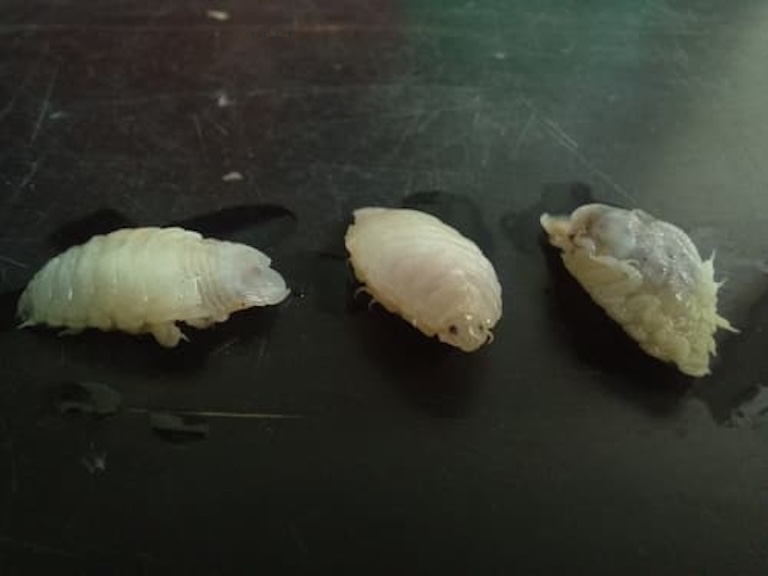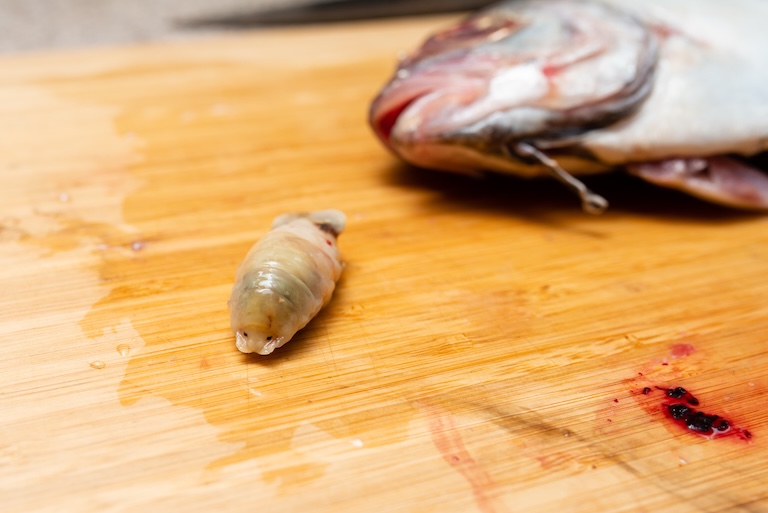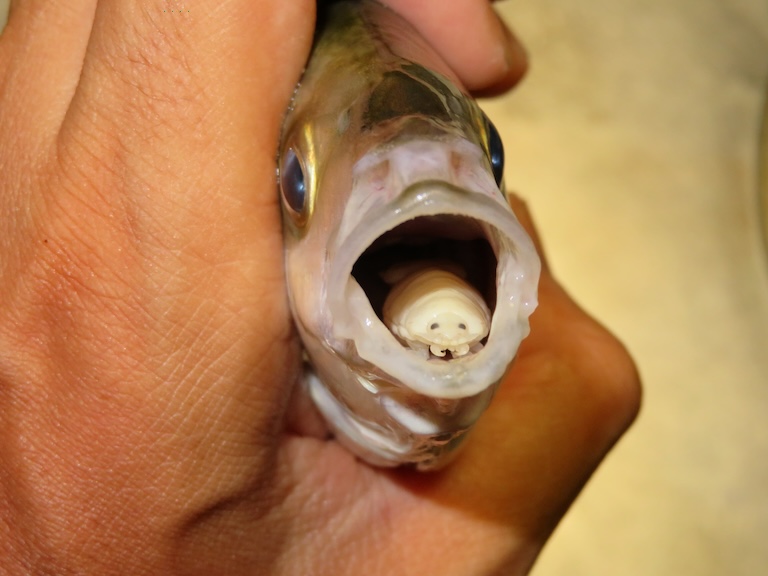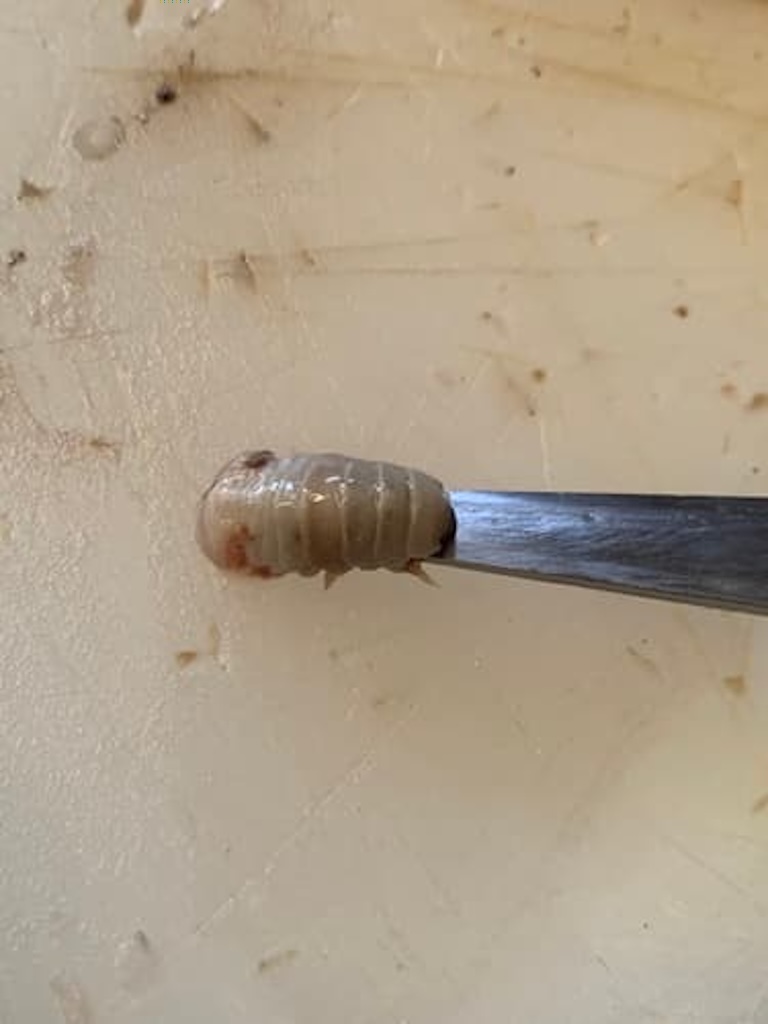Tongue-Eating Louse Profile
Unless you’re an Orca it must truly suck to live in the ocean. Regardless of what you are, you’re surrounded by things that want to eat you, and some of them do it so slowly that you’ll have to swim around all flustered and upset for the lengthy duration of the process.
The best you can hope for is being pulled out of the water and left to suffocate on the deck of a boat, and some of the worst must picking up any number of parasites you don’t have the fingers to pluck off, nor the range of facial expressions to really do the situation justice.
The Greenland shark’s eyeball parasite comes to mind, but a close contender has to be the isopod that snips off a fish’s tongue and then lives in its mouth, stealing blood, forever.

Tongue-Eating Louse Facts Overview
| Habitat: | Fish mouths |
| Location: | East Pacific, some parts of the Atlantic |
| Lifespan: | Unknown |
| Size: | Up to 3 cm (1.1 in) long |
| Weight: | Not listed |
| Colour: | Yellow-brown |
| Diet: | Fish blood and mucous |
| Predators: | None known |
| Top Speed: | Depends on the fish |
| No. of Species: | 1 |
| Conservation Status: | Not listed |
These horrible little cousins of the humble woodlouse are just trying to make it through life the only way they know how.
Unfortunately for everything, this way is one of snipping and biting and living inside a hapless victim’s mouth and stealing their nutrients. These are as hard to look at as they are to swallow and make a great reminder of how lucky we are to have medicine.
Interesting Tongue-Eating Louse Facts
1. They’re isopods
Isopods are tremendously successful little crustaceans, and you need to look no further to prove this than under the nearest rotting log.
Woodlice are isopods and cute ones at that, but they can also be found in freshwater and marine habitats, where they express a range of feeding behaviours from chewing decaying plant matter to filter feeding, to predation.
The tongue-eating louse isn’t as straight up as any of this and prefers the parasitic approach. This is a member of a whole family of parasitic isopods, commonly considered real jerks of the animal kingdom, and this is just one of almost 400 species like it.
The genus Cymothoa contains some less-intense freeloaders, such as those who will just hitch a lift on a fish, but the widespread Cymothoa exigua is not so kind.
While woodlice are the gentle ankylosaurs of the arthropod world, the tongue-eating louse is more like Ridley Scott’s chest-buster.

2. They’re ugly
There must be some distant DNA-driven understanding of what parasites look like because this one triggers the same sort of unease you get when you see maggots living inside someone’s skin.
These are large isopods, and people who have had to deal with them call them hideous, ugly, nasty, and other horrible things commonly uttered by Donald Trump about women.
Coincidentally, tongue-eating lice have a bunch of sharp appendages underneath them that sort of rattle disturbingly at you when you turn them over, which is one of the features most women report they’d most like to have if left alone anywhere near Trump. 1
3. They amputate the tongue
It’s not clear how much eating of the tongue goes on by this so-called tongue-eating louse. While still pretty horrific, it seems to have been misjudged in this regard, at least.
Instead, the frontmost pair of these claws are for latching onto and severing the blood vessels in their host, a fish’s, tongue. The lack of blood kills the tongue, which drops off and leaves a tongue-shaped hole into which the relatively tongue-shaped parasite sits.
4. And then replace it
The fish tongue doesn’t appear to be a work of evolutionary intricacy. It’s not used for talking, it doesn’t have tastebuds, and they don’t appear to have reason to stick it out at one another very often.
So, replacing it with a mean little isopod might not cause a whole lot of damage. It appears that the parasite does nothing else to harm the fish, and just occupies the mouth where the tongue once was until it’s finished its bidding.
Some say it’s the only known case where a parasite functionally replaces a host’s organ, but this might be a bit of a stretch, considering that the tongue’s function is so limited to begin with, and the fact that the original tongue didn’t steal blood from the fish to eat.
Further, the fish found with these parasites aren’t thought to be as healthy. 2

5. This makes the fish smaller
Another reason the “functional” part of the tongue replacement is under question is the overall health of the infected fish. One research paper compares both condition and growth assessments in host species and compares infected fish against uninfected fish.
It concluded that there were no significant differences in the condition of the fish but significant differences in their growth. Infected fish were smaller, suggesting the parasite does negatively impact the host, and likely increases its mortality in the same way. 3
6. They’re protoandritic hermaphrodites
But enough about the poor fish! It’s time to talk about the lifecycle of the horrible parasite.
Being mostly found on fish, and perhaps exclusively so, that stage is about all that can be found regarding its life, though they are thought to attach to the gills of the host as smaller males, after which, one will mature into a female to mate with the gillboys and take over the tongue.
As isopods, they likely have eggs that mature beneath them amid their wriggly sharp appendages, but where they go after this and how they go about finding their own host is still a bit of a mystery.
7. They also eat mucous
The fate of the tongue after the fish has died is a matter of debate. Whether the adult female dies from lack of nutrients or pops off to find another host isn’t known.
Many sources make the claim that the parasite also feeds on the natural fishy mucous that is secreted by the host, and perhaps even some of the morsels it catches in its mouth to eat.
Regardless of its diet, though, having been through its free-living stage, it’s unlikely to be able to return to one, so hopefully the tongue-eating louse does eventually go down with the ship. 4

Tongue-Eating Louse Fact-File Summary
Scientific Classification
| Kingdom: | Animalia |
| Phylum: | Arthropoda |
| Class: | Malacostraca |
| Order: | Isopoda |
| Family: | Cymothoidae |
| Genus: | Cymothoa |
| Species: | exigua |
Fact Sources & References
- (2009), “Rare tongue-eating parasite found”, BBC News.
- Bill Chappell (2021), “The tongue-eating louse does exactly what its name suggests”, npr.
- Ruiz-L (1992), “Studies on the biology of the parasitic isopod Cymothoa exigua Schioedte and Meinert, 1884 and it’s relationship with the snapper Lutjanus peru (Pisces: Lutjanidae)”, Universidad Nacional Autónoma de México.
- Mary Bates, (2012), “Tongue-eating parasites inspire new horror movie”, AAAS.
